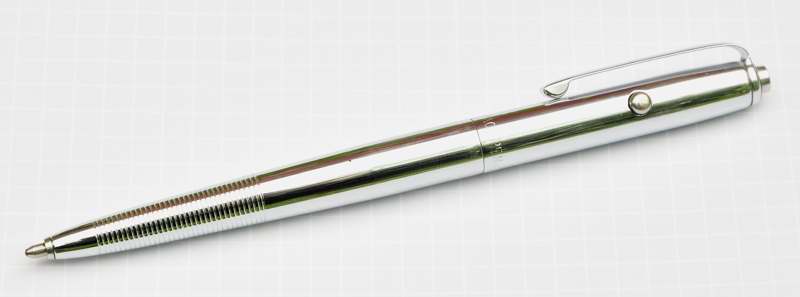
Fisher AG7 Anti-Gravity Pen – the original Space Pen first used by astronauts in 1968 on Apollo 7
Credit: Canit
Conventional ball-point pens depend on gravity to feed ink to the ball. You've probably seen this when trying to write with a ball-point using a vertical surface to support the paper – delivery of ink to the ball soon fails, & the ball-point stops writing.
Another consequence is that conventional ball-point pens don't work in micro-gravity environments, such as Earth-orbit.
You’ve probably seen the stories circulating on mail lists, that go something like this:
US Government/NASA spent thousands/hundreds of thousands/millions/many millions of dollars developing a ball-point that would work in micro-gravity, & the USSR used a pencil. Stupid/incompetent/wasteful US Government/NASA. Clever USSR.
This story is wrong at every turn:
1. neither the US Government, nor NASA, ever spent a cent on development of a ball-point pen for use by astronauts
2. pencils were used in the early days of both the American & Russian space programmes
3. a pencil is a threat to safety in a space vehicle – pencil “lead” is substantially graphite, a form of carbon, which can burn – a no-no in space vehicles, since the fatal Apollo 1 fire in 1967
4. in use, pencil “lead” can release tiny flakes or break – this poses no threat on Earth – gravity takes care of that – in microgravity, small pieces of floating pencil “lead” may be inhaled or enter other bodily openings
5. small pieces of floating “lead” in a micro-gravity environment can interfere with the operation of sensitive equipment
6. graphite in pencil “lead” is electrically conductive, adding short circuiting to the risks posed to electrical equipment
7. soon after a suitable ball-point pen became available, the USSR began using it too
Development of the Space Pen was entirely funded by the Fisher Pen Company, under the direction of founder Paul C. Fisher. A cost of $US1 million has been claimed.1
Actually, what allows the Fisher Space Pen to write in micro-gravity is the refill.

Fisher Space Pen refil
Credit: Sidetek/Blogger
Ink is delivered to the ball in any orientation, with or without gravity, by gas pressure. Ink continues to flow at temperatures ranging from -30°F to +250°F (-34°C to 121°C).2
Fisher's original Space Pen, the AG7 Anti-Gravity Pen, first flew in space in 1968 on Apollo 7.
You can still buy an identical pen from Fisher at http://www.spacepen.com/originalastronautspacepen.aspx
Snopes – “The Write Stuff”, http://www.snopes.com/business/genius/spacepen.asp
Scientific American – “Fact or Fiction?: NASA Spent Millions to Develop a Pen that Would Write in Space, whereas the Soviet Cosmonauts Used a Pencil”, https://www.scientificamerican.com/article/fact-or-fiction-nasa-spen/
__________
1 Scientific American: “Fact or Fiction?: NASA Spent Millions to Develop a Pen that Would Write in Space, whereas the Soviet Cosmonauts Used a Pencil”, https://www.scientificamerican.com/article/fact-or-fiction-nasa-spen/
2 Fisher Space Pen Co: “About Us”, http://www.spacepen.com/about-us.aspx / pencil lead graphite carbon fact or fiction NASA spent millions develop biro ball point pen write in space Soviet cosmonauts used pencil problem weightless writing Soviet central planning American sub-contracting private investor space race 1960s millions of taxpayer dollars develop pen ink paper without gravity Soviet cosmonauts pencils message simplicity thrift failure common sense bureaucracy Internet NASA Soviet cosmonauts used pencils outcry NASA find something cheaper astronauts tips flaked broke off drifting in microgravity potentially harm astronaut or equipment pencils are flammable NASA avoid Apollo 1 fire Paul C. Fisher Fisher Pen Company invested $1 million create commonly known as the space pen investment money NASA's coffers 1965 Fisher patented pen write upside-down frigid or roasting conditions underwater other liquids Fisher AG-7 Anti-Gravity Space Pen NASA testing space pen spaceflights beginning in 1967 ball-point pen ballpoint pen Fisher's pen gravity ink flowing cartridge pressurized nitrogen 35 pounds per square inch pressure pushes ink toward tungsten carbide ball pen tip ink ink stays gellike solid movement of the ballpoint turns it into a fluid pressurized pressurised nitrogen prevents air from mixing with the ink cannot evaporate or oxidize oxidise February 1968 NASA ordered 400 Fisher's antigravity ballpoint pens Apollo program Soviet Union ordered 100 pens 1,000 ink cartridges Soyuz space missions 40 percent discount buying in bulk /
No comments:
Post a Comment